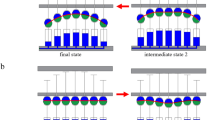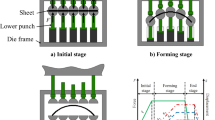Abstract
In order to study the shape accuracy of multi-point forming (MPF) process for sheet metal under normal full constrained conditions, the in-depth analysis of shape accuracy of workpieces in multi-point forming with individually controlled force-displacement (MPF-ICFD) process is conducted in this paper by combining experiment, theoretical analysis and numerical simulation. The influences of normal force, material thickness and material properties on the shape accuracy of the feature surface are studied, and the shape accuracy characteristics of the sheet under different parameters are obtained. Afterwards, the stress and strain characteristics of sheets are obtained by numerical simulation. Finally, the effect of normal force on shape accuracy was revealed by establishing a mechanical model of the sheet metal under normal full constrained conditions. Moreover, the amount of springback reduction in MPF-ICFD is defined quantitatively. Compared with the normal unconstrained conditions, the shape accuracy of sheet metal is improved significantly under normal full constrained conditions. The stress and plastic deformation are more uniform and the amount of springback is smaller. For Q 295 steel plate with thickness of 2.0 mm, the difference between the maximum value and the minimum value of the reaction force of punch decreases from 4515.9 N to 1475 N when the forming force is 2500 N. Besides, the bending moment of the sheet on the unit width decreases from 357.9 N • mm to 328.1 N • mm. The average shape error E rr and the amount of springback Δk decreases by 60.05% and 16.03%, respectively.












Similar content being viewed by others
References
Paunoiu V, Cekan P, Gavan E, Nicoara D (2008) Numerical simulations in reconfigurable multipoint forming. Int J Mater Form 1(1):181–184
Behrooz ZD, Behnam D, Ali VS (2015) Investigation of deep drawing concept of multi-point forming process in terms of prevalent defects. Int J Mater Form 10(2):193–203
Gong XP, Li MZ, Lu QP, Peng ZQ (2012) Research on continuous multi-point forming method for rotary surface. J Mater Process Tech 212(1):227–236
Walczyk DF, Lakshmikanthan J, Kirk DR (1998) Development of a reconfigurable tool for forming aircraft body panels. J Manuf Syst 17(4):287–296
Li MZ, Cai ZY, Sui Z, Han QG (2002) Multi-point forming technology for sheet metal. J Mater Process Technol 129(1–3):333–338
Le L, Young HS, Seong CH, Beom SK, Jeong K (2010) Numerical simulations on reducing the unloading springback with multi-step multi-point forming technology. Int J Adv Manuf Technol 48(1):45–61
Edwin H, Robert CS, John MP (2002) Design and test of a reconfigurable forming die. J Manuf Process 4(1):77–85
Boers SHA, Schreurs PJG, Geers MGD (2004) Optimum path and discrete 3D forming http://www.mate.tue.nl/mate/pdfs/5933.pdf
Liu ZW, Li MZ, Han QG (2012) Multi-point forming with wrinkle resistance function and its forming accuracy. Stroj Vestn-J Mech E 48(12):56–62
Li MZ, Liu YH, Su SZ, Li GQ (1999) Multi-point forming: a flexible manufactruing method for a 3-d surface sheet. J Mater Process Technol 87(1–3):277–280
Jia BB, Wang WW (2016) New process of multi-point forming with individually controlled force-displacement and mechanism of inhibiting sprinback. Int J Adv Manuf Technol 90(9):3801–3810
Zhang QF, Cai ZY, Zhang Y, Li MZ (2013) Springback compensation method for doubly curved plate in multi-point forming. Mater Des 47:377–385
Yan AM, Klappka I (2008) Springback in stretch forming process of aeronautic panel production by finite element simulation. Int J Mater Form 1(1):201–204
Braga MT, Moreira Filho LA, Menezes MA (2010) Springback analysis of thin bent sheets on elastomeric. Int J Mater Form 3(1):1075–1078
Peng LF, Lai XM, Li MZ (2005) Transition surface design for blank holder in multi-point forming. Int J Mach Tools Manuf 46(12–13):1336–1342
Zhang Q, Fan SQ, Zhao SD, Wang CH (2010) Numerical simulation research on a new spinning process: double-roller clamping spinning process. Int J Mater Form 3(1):121–125
Behnam D, Behrooz ZD (2014) Assessment of forming parameters influencing spring-back in multi-point forming process: a comprehensive experimental and numerical study. Mater Des 59:103–114
Liu W, Chen YZ, Xu YC, Yuan SJ (2016) Evaluation on dimpling and geometrical profile of curved surface shell by hydroforming with reconfigurable multipoint tool. Int J Adv Manuf Technol 86(5):2175–2185
Cai ZY, Wang SH, Xu XD, Li MZ (2009) Numerical simulation for the multi-point stretch forming process of sheet metal. J Mater Process Technol 209(1):396–407
Acknowledgements
This study was financially supported by the National Natural Science Foundation of China (No. 51505103, No. 51175109). The authors wish to express their gratitude to the funding.
Author information
Authors and Affiliations
Corresponding author
Ethics declarations
Funding
This study was funded by the National Natural Science Foundation of China (No. 51505103, No.51175109).
Conflict of interest
The authors declare that they have no conflict of interest exits in the submission of this manuscript, and manuscript is approved by all authors for publication.
Rights and permissions
About this article
Cite this article
Jia, Bb., Wang, WW. Shape accuracy analysis of multi-point forming process for sheet metal under normal full constrained conditions. Int J Mater Form 11, 491–501 (2018). https://doi.org/10.1007/s12289-017-1359-2
Received:
Accepted:
Published:
Issue Date:
DOI: https://doi.org/10.1007/s12289-017-1359-2




